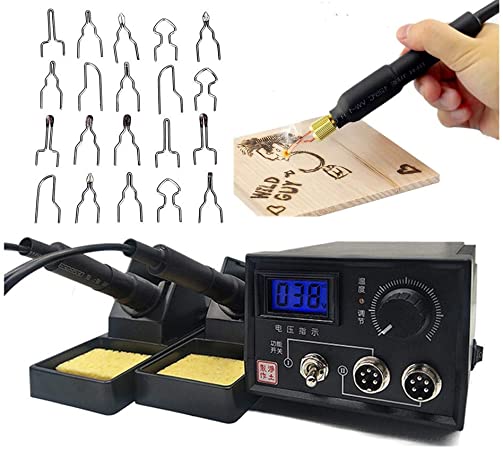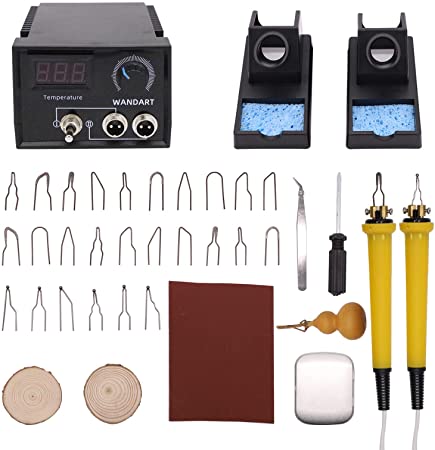
A wood burning project is a great way to give your children a unique gift. Burning pictures that they've made is a great way to let them express their creativity, and a wooden toy made from their drawing can make a memorable keepsake. To make a unique gift, you can also use a template for your children's drawings.
Avoid burning wood that is grainy, resinous and have a dark color
Before you burn wood, make sure you know which type you are going to be using. Some types of wood are better than others for certain purposes. Select a wood that is lightweight and easy to cut. You will need to season wood that is light or grainy if it is not green. Lightly seasoned wood has darkened ends, visible cracks, and is relatively light. It gives off a distinctive sound when two pieces are struck together. If you do decide to use wood that is dark and resinous, you should avoid burning pine.
You should choose wood that is at least a third the thickness for the final project. For crafts, a minimum of 0.38 in (9.5mm) thickness is required. Thicker wood will crack and smoke easily. Plywood will quickly fade designs and paint can smear. Resinous or painted wood will release toxic fumes into the atmosphere and produce toxic fumes.
For pyrography, lighter woods are better. Lighter woods are typically less expensive and have a smaller grain. Because they don't have as much resin, light woods are not as dense as dark-colored ones. Beech is a good choice for beginners. Be aware of the dangers of glue and wood with a pattern.
Avoid burning wood over glue lines
You can avoid burning wood by making sure that glue lines do not get too moist. Glue lines are more conductive than wood. This is because the current is concentrated on the line. It results in a rapid cure time. But, other factors can also contribute to the burning process, including the wood's shape and any peculiarities. These tips will help you avoid burning wood on glue lines.
It is best to avoid using epoxy over wood.

You might want to reconsider your safety precautions if you have been sanding a deck that has just been installed. Epoxy can lead to respiratory problems. Sensitization can occur from prolonged exposure to epoxy. The symptoms can vary from skin irritation to respiratory issues. Exposure to epoxy can cause inflammation of the skin and respiratory system. Other side effects include red eyes, itching, and rash. These reactions can range from mild to severe, but are unlikely to be life-threatening.
For epoxy production, wood is an excellent resource. While it can be expensive and not appropriate for every project, it is inexpensive and can be collected from fallen trees. Epoxy is very flammable. Avoid burning wood on top of it. The epoxy can ignite if you burn wood. If you do decide to use this product, make sure you follow the manufacturer's directions to avoid damaging the finish.
When using epoxy, be sure to wear gloves when mixing the mixture. It is important to wear gloves when mixing epoxy. The epoxy will harden quickly so be sure to keep your hands clean. It's as simple as pouring a bath. The only difference between the two is that epoxy poured into wood may run into other areas. Therefore, it is crucial to make sure it is evenly poured. Using a foam brush to apply the epoxy doesn't give you the uniform surface that you'll need.
FAQ
How does a beginner woodworker earn money?
Many people are starting to learn how to build furniture because they want to start an online business. If you are just starting to build furniture, there are many other ways to make money than selling on Etsy. You could sell at craft fairs or local events. You could also offer workshops to help others learn how to make their own furniture. If you have the experience to be a carpenter, builder, or a designer, you may consider offering your services in remodeling homes or creating custom pieces.
Can this be a way to make money?
Yes! Many woodworkers have this ability. According to the U.S. Bureau of Labor Statistics' (BLS), in May 2012 the median annual wage of woodworkers was $34,000 That's higher than the national average of $31,000 per year.
Do I have to refinish my furniture?
Yes! There are many options for refinishing furniture that you don't need to hire a professional. Here are some ideas:
Use sandpaper on the surface to remove any stains or scratches. Finally, use a clean cloth or sponge to clean the surface.
Clear polyurethane varnish should be applied. Allow furniture to dry completely before you move it around.
Use acrylic paint to paint furniture.
You can stain the furniture instead of using paint. The furniture will have a rich look thanks to the stain.
Use shellac wax. Wax will protect the wood and add shine.
What would you recommend as a starting material for woodworking?
Start with softwood like pine, poplar and ash. You will feel more comfortable with these softwoods, so you can move onto hardwood.
Statistics
- If your lumber isn't as dry as you would like when you purchase it (over 22% in Glen Huey's opinion…probably over 10-15% in my opinion), then it's a good idea to let it acclimate to your workshop for a couple of weeks. (woodandshop.com)
- The U.S. Bureau of Labor Statistics (BLS) estimates that the number of jobs for woodworkers will decline by 4% between 2019 and 2029. (indeed.com)
- In 2014, there were just over 237,000 jobs for all woodworkers, with other wood product manufacturing employing 23 percent; wood kitchen cabinets and countertop manufacturing employing 21 percent. (theartcareerproject.com)
- Woodworkers on the lower end of that spectrum, the bottom 10% to be exact, make roughly $24,000 a year, while the top 10% makes $108,000. (zippia.com)
External Links
How To
How can you measure wood accurately?
There are many methods for measuring wood. We use a digital ruler (a tool to measure distances), laser level (used for leveling your work surface), and bubble level (used for levelling your work surface).
A digital caliper has two jaws that open and close. One jaw holds the measured object while the other measures the distance between the two points. Digital calipers are great for measuring small distances, such as thicknesses of wood.
Laser levels are equipped with an infrared light beam, which projects a line across a floor. The laser emits an infrared light beam that projects a line across the floor. By looking down the line, you can see whether the surface is even or not. For large surfaces, laser levels are the best way to check their accuracy.
Bubble levels look similar to a compass. There is a bubble in the center of the device. As long the bubble is not in the middle, the device will show you whether the surface of the object is level. For checking the accuracy of small areas, bubble levels are useful.